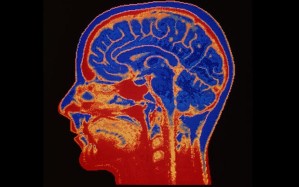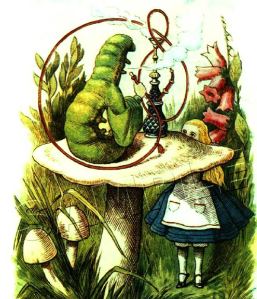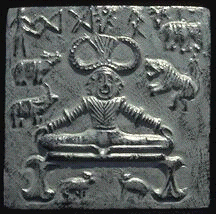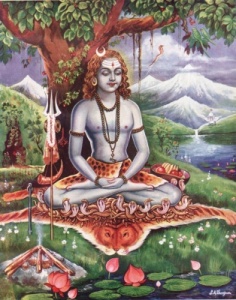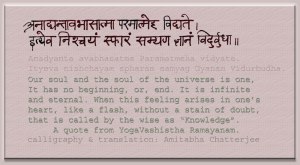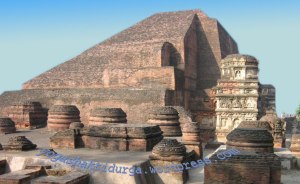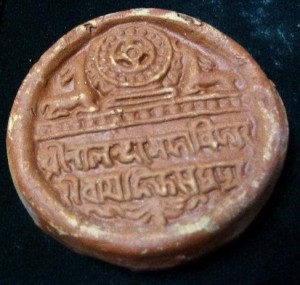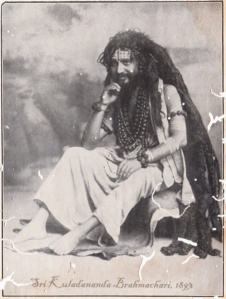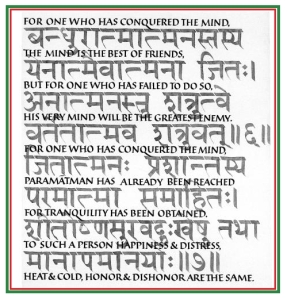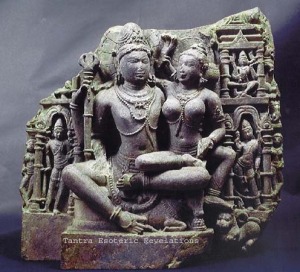Vatuka Bhairava Apaduddhara Stotram consists of 108 names of Bhairava (Wrathful form of Shiva), which confers blessings and delivers the practitioner from danger. Kavacha, or, Kavacham means amulet or, armor. These verses or, hymns constitute a mantra armor. Apada (trouble / danger) + Uddhara means release from danger. After protracted practice, anyone is miraculously rescued by Bhairava, once these 108 names are invoked. Whoever recites them is delivered from diseases, the malefic effects of planets, the evil influences of ghosts, demons and black-magic. The harmful entities flee from the spot on hearing the powerful invocation of the names of Bhairava.
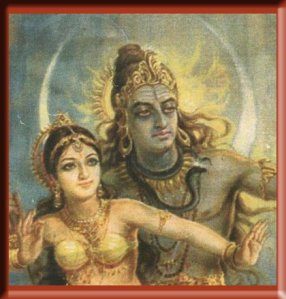
Shiva-Nataraja and consort Parvati in dance posture.
The seer or, Rishi (who first realized this mantra in his trance) of these mantras is Brihadaranyaka; the rhythm (chhanda) in which this mantra must be uttered is Anustupa. The god appeased here is Vatuka Bhairava ; the viniyoga or, application is siddhi (Attainment of something), well-being and success in life. The principal mantra for Vatuka Bhairava, with Shakti Bija (root syllable) is this:
Om Hreem Vatukaya Apad-uddharanaya kuru kuru Vatukaya Hreem
As in all Tantras, the presentation of Apaduddhara Stotra begins as a dialogue between the supreme being Shiva and his consort, goddess Parvati. Parvati asks Shiva to tell her the 108 names of Vatuk Bhairava, such that, pious devotees may find a way to get rid of all problems and sorrows in life and find happiness.
Bhairavo Bhuta-Nath-ascha Bhutatma Bhuta-Bhavanah,
Kshetradah kshetrapal-ascha Kshetragya Kshatriyo Virat.
meaning:
Bhairava is Bhutanath (lord of all living things), Bhuta-atman (soul of all life-forms), Bhuta-bhavana (always contemplates on the welfare of living beings). He is the giver (Kshetra-da) of Kshetra (physical body/Prakriti with 3 gunas) & it’s guardian (Kshetra-pala), the holder of Kshetra-wisdom ( Yogic wisdom ), Kshatrya (warrior), Virata (all pervading, gigantic).
Smashan-vasi Mangsashi Kharparashi-r Makhanta-krit.
Raktapah Pranapah Siddhah Siddhidah Siddha-sevitah.
means:
He, being a form of Shiva, resides in Charnel grounds or, lonely cremation grounds (smashana), he accepts offerings of flesh (mangsa), his bowl is a skull (kharpar). He is the ender (or, he completes Makha = yajna) (fire-sacrifice) (meaning, an auspicious Tantric ritual is incomplete without him.) (also, destroyer, like Veerbhadra destroyed Dakhsa Yajna, on Shiva’s order.) He drinks blood and Prana (Vital force) [Bhairava bestows superior vital energy as blessing, or, diminishes vital power as a curse]. He is a Siddha (Complete Adept/Accomplished) himself, and a Giver of Siddhis (Power over some aspect of nature), and is worshipped by other Siddhas.
————————————————
Karaalah Kaala-shamanah Kala-kastha-tanuh Kavih.
TriNetra BahuNetra_scha tatha Pingala-Lochanah.
Shula-panih Khadga-panih Kankali Dhumra-Lochanah.
meaning:
Bhairava is Karaala (Terrible), Kaala(Death)-Shamana (Yama, God of death) [he is the Death of death, Kills death], Kala-kastha(units of measurement of time)-Tanu (body) [He is the embodiment of Time], Kavi (Poet, also means, he can see beyond the limits of Time). He has 3 eyes (Tri-Netra), bahu-netra (many eyes), his eyes are Pingala (honey-yellow in color) [Lochana=Netra=eye]. The weapons in his hands are Shula(Spear/Trident), Khadga (Sword), Kankala(Skeleton or, may imply Vajra, made from the indestructible bones of sage Dadhichi). His eyes are also smoke-grey (Dhumra).
Abhirur Bhairavo Bheemo Bhutapo Yogini-pati.
Dhana-do Dhana-hari cha Dhanadah Pratibhava-van.
meaning:
Bhairava is utterly fearless (Abhiru), gigantic and powerful (Bheema), He is the master of the 5 basic elements that constitute the universe(Pancha Bhuta ), He is the master of Yoginis. (master/Lord=Pati). He is the bestow-er of riches (Dhana-daata; dhana=riches), and also the Taker (He takes them away= Dhana-haari); He is Talented, a genius, the master of all ingenuity (Pratibha).
In case, you are wondering what the hyphens – and _underscores are for, here’s the explanation. I have used them to separate meaningful words in Sanskrit, so that the reader can clearly understand and pronounce them. Tri Netra (meaning, tri=three, netra=eye). Ascha & tatha are grammar parts that join sentences… they mean “and”, or, “also”. Tatha also means “there /likewise”. But for now, don’t worry about grammar. Stick to the meaning of the individual names of Bhairava. For, its only a list of 108 names, remember?
———————————————————————–
Naga-haro Naga-kesho Vyomkesha Kapala-bhrith.
Kaalah Kapala-mali cha Kamaniyo Kala-Nidhih.
meaning: Naga= snake, hara=garland, Kapala = skull, mala= garland, Kesha=hair. Sri Bhairava is described as wearing a garland of snakes around his neck. Snakes are slithering among his matted locks of hair. He shares the Name Vyomkesha with Shiva, which means that his hair covers the whole span of the sky. Shiva outspread his matted locks all over the sky to catch and bind the celestial river Ganga, as she descended from heaven.He holds a skull in his hand and a garland of skulls adorns his chest.
—————————————————————————-
Kapala-bhrith (Bhairava carries Brahma’s skull like a bowl): Puranic story:
The skull in his hand is that of Brahma-deva, the creator of this universe. Brahma, the creator, became egoistic, and lied about finding the upper end of the pillar of divine light. This endless pillar is eternal knowledge and Shiva himself. While Brahma was boasting of his superiority to Vishnu, who was humble and quiet (for Vishnu accepted that he failed to find the bottom of the Pillar, even after searching for thousands of years), Shiva came out of the pillar. Shiva looked at Brahma with disapproval and suddenly Bhairava emerged from his contorted brows. Shiva ordered Bhairava to chop off Brahma’s head for lying. As Brahma stood trembling with fear, Bhairava produced a divine sword and chopped off Brahma’s fifth head, which uttered the untruth. As Bhairava proceeded to cut-off all the remaining heads of the creator, Lord Vishnu requested Shiva to forgive Brahma. Shiva praised Vishnu for being humble, truthful and courageous and forbade Bhairava to kill Brahma. Shiva blessed Vishnu that all his 10 avatars will be worshiped on earth and Vishnu will be the protector of the Universe. And cursed Brahma that he will not be worshiped, in spite of being the creator.
Shakti’s skull and immortality
The skulls in his garland are those of goddess Shakti as Sati (Sati= Parvati’s previous incarnation) from all her previous births. Shakti left Shiva many times in the past, casting off her mortal body. Immortal Shiva collected her skulls & made a garland; and from her bones, he made a rosary. Shakti’s avatars, before Parvati were mortals. Shiva made Parvati perform astounding austerities and yoga, before accepting her as his consort. Parvati attained immortality and her yogic feats enabled her to emanate the various wrathful forms to slay demons (Durga, Ambika, Kali, Chandi, Chamunda, Kaushiki, Bhadrakali, etc.).
He is Kaala, time itself (also, Kaala= death). He is extremely beautiful & handsome. He is the god of all art-forms. All the classical music, Raga, Raginis, Dance postures have evolved from Lord Shiva.(Kala=art, nidhi=gem/treasure).
Tri-lochan-Ujjvala-netras Tri-shikhi cha Tri-loka-path.
Tri-britto-Nayano Dimbhah Shantah Shanta-jana-praiyah.
Tri= three, nayana=lochana=eye, Loka=world. shanta=peaceful, priya=favourite.
Bhairava has three large bright eyes. His hair is arranged in 3 matted locks (tri-shikha). He is the lord of the 3 worlds, he nurtures (Patha= who nurtures, maintains) and sustains them. He is the embodiment of Peace and loved by all those who have attained peace of mind. Dimbha= child, Vatuka also means small child.
Vatuko Vatukeshas cha khatvanga-vara-dharaka.
Bhutadhyakshah Pahupatir Bhikshukah Paricharakah.
meaning:
He is called by all these names : Vatuka, Vatukesh, Bhutadhyaksha, Pashupati (lord of all animals), Bhikshuka and Paricharaka. He holds the Vara (blessing) gesture and the Khatvanga weapon in his hands. Now, Bhuta Preta= elemental lifeforms like Ghosts, made of subtler panchabhutas.
Pashupati
(Bhairava is the master of all animals ) Pashu literally means Animal. But those human beings who are not liberated, are also considered as Pashu (animals) in Tantra. Pash means bondage. Whoever is bound by ignorance is a Pashu, or, animal.
Bhairava wanders in this world taking the disguise of a beggar (Bhikshuka), with the skull of Brahmadeva as his begging bowl. Paricharaka = He who takes care of the distressed/ needy. So, Bhairava is both a beggar and the giver of alms in the form of riches, boons and knowledge.
Dhurtto digambarah shaurir-harinah pandu-lochanah.
Prashantah shantidah suddhah shankarah priyabandhavah
Meaning:
Dhurtto { धूर्त } = clever; cunning.
digambara= naked, Dik-Ambara, The directions(Dik) are his cover(ambar अम्बर )(= unclad);
Shauri { शौरि }=means Vishnu;
Harina { हरिण } = Shiva, Vishnu, Hamsa and white-colored;
Pandu-lochana= eyes are yellowish-white in color;
Pashanta= He who has attained total peace; Shanti= peace; Shanti-da = Peace-giver;
Shuddha= Pure;
shankarah priyabandhava= it may be interpreted like:
1) Dear friend of Shiva Shankara
2) He is Shankara (shiva) and Close-Friend of the devotee.
Pra-Shanta= He who has attained total peace;
=================DIGAMBARA==================
Digambara (Dik + Ambara)= naked, unclad. Shiva is all-pervading, infinite, so the directions (Dik) are unable to envelop him like a cloth(Ambara). He is naked, as he is infinite.
shaurir-harinah= Divine like Shiva or, Vishnu.
Shanti-Da, Shanti-data= He who Grants or, Bestows peace.
—————————————————————————
Asta-murtir-Nidhisha-scha Gyan-chakshus Tamomayah.
Astadharah Kaladharah Sarpayukta Shashi-shikhah.
Means:
Asta=8, murti=form, Nidhi=Treasure, Isha=master/Lord, Gyan=knowledge, Chakshu=eye, Tamo=Tamo-guna, Adhar=support, Kala=Art, Sarpa=snake, yukta=with (snake), Shashi=moon, Shikha=Top of the head/Jata.
Vatuka / Batuk Bhairav appears in 8 forms and lends his support in 8 ways (I think, something about the 8 directions, 4 cardinals, 4 in-between), He is the Lord of all treasures and art. Although he appears in Tamasic forms(Like drinking wine, eating flesh, accepting animal sacrifices, wandering in cremation grounds, etc.), he is totally enlightened. He can see everything at all times, past, present and future. He like Shiva, has snakes around his neck and a crescent moon emits pleasant light from his matted Jata. (Diseases and fatigue of devotees disappear by meditating on this moon)
————————————————————————–
Bhu-dharo Bhudhar-adhisho, Bhupatir-Bhudhar-atmakah.
Kankaal-dhari Mundi cha Naag-Yajnopabita-vaan.
Bhu=Earth, Pati=lord, Kankaal=skeleton, Munda=head, Naag=snake,
Yajnopabita=Holy threads that Brahmins hang from their left shoulder. {NOTE:- But in the past Brahmins, as well as ksatriyas/kinsmen/warriors and Vaisyas/trader-clans used to take part in fire sacrifices ( All the first 3 of the 4 castes of ancient India. Only the Sudras were left out ). In the beginning of the sacrifice, after the initiation ceremony, they were given this threads to wear. Some sacrifices could take several days to complete.}
Vatuk Bhairav is the Lord of this world, this earth and this soil. He is also master over those who hold this world (like the King of snakes named Vasuki), or over those who rule earth. He wears ornaments made from bones and also garlands of human heads around his neck (Belonging to Brahma, Sati, etc. as explained earlier). His sacred-thread is made from a coil of snakes, instead of string. This snake symbolism signifies the mastery over Kundalini energy.
———————————————————————————
Jrimbhano Mohanah Stambhi Maranah Kshobhanas-tatha.
Shuddha Neelanjana Prakkho-deho Munda-Vibhushitah.
Jrimbhan=Yawning, inducing a sleepy state; Mohana=Hypnosis, Stamnhan=Stupefy/Paralyze, Marana=to kill, Kshobhan=to induce restlessness. These are actually weapons/Astra-vidyas. Ancient yogis going back to the Vedic era possessed these powers. In the Puranic era, and the era where Tantra prevailed, these were coveted and feared. Deva-Guru Vrihaspati’s brother paralyzed Indra’s hand, as the latter raised his Vajra to attack (Indra=Zeus, king of heaven)… through a fire ritual (Stambhan); Again, Arjuna single-handedly, put the whole Kaurava army to sleep by a weapon called Jrimbhakastra, in Virata- war.
Yogi Jalandhar Nath (Jalandhari Pa, guru of Kanipa Nath) was annoyed with some gods (who disagreed and displayed insubordination ) and put them under hypnosis (Mohana). When they came to their senses, they were hanging upside-down from trees, pleading for release! Yogi Gorakhnath induced unhappiness (Kshobhan) in the marital life of King Bhartrihari to pull him out of his household and royal pleasures. Bhartrihari became a great Nath yogi called Vichar Nath. He is also the author of Vairagya-Shataka (100 verses on Dispassion) & Vakyapadiya (an original work of Sanskrit grammar, at par with Panini’s sutras.). Sage Kapilmuni burnt to ashes with his gaze (Marana), 1000 princes of Sagara dynasty. On the hands of unselfish Yogis, these powers were always applied for some greater good. Like the Sagara king Bhagirath, who brought down river Ganga from heaven to deliver his burnt ancestors. So, in a way, Kapil Muni’s action was the cause and the descent of Ganga was the result.
All the above powers are granted to the proper devotee of Bhairava, who will not try to use them for evil ends. These are called Abhichara kriya or, Krura-Karma (Cruel deeds) in Tantra. A Tamasic meditation is suggested here. Vatuk Bhairava’s body is dark (blue black) like the purest Kajal/ Netra-Anjana (Prepared from Lamp-soot), he is decorated with a garland of human skulls.
————————————————————————————
Balibhuk balibhutatma kami kama-parakrama.
sarvapat-tarako durgo dusta-bhuta-nishevitah.
He accepts sacrifices(balibhuk=eater of sacrifices), Himself being the soul of all his sacrifices (bali bhutatma); he is the pinnacle of all desires of here and here-after. He is the destroyer of Kama (Shiva burnt Kama-deva, the god of desire, to ashes with a gaze from his third eye.)
He is difficult to reach (Durgo)(cannot easily be found), He is the Rescuer from all misfortunes and troubles ( sarva= all. Apada= trouble; Taraka = Rescuer, Saviour ).
He (puts down by force) curbs evil-spirits and withholds them. Bhairava is an emanation of Shiva. He was given the responsibility to protect & preserve Deva-sthana-s, especially shrines of Shiva and the 51 Shakti-Pithas that sprang up from the 51 body parts of mother goddess Sati. Lord Bhairava, who could cut off Brahma’s head, is a supremely powerful being. So, all malefic spirits meekly serve him for fear of destruction. Hence Bhairava is dusta-bhuta-nishevitah.
Kaalah Kalanidhi Kantah Kamini-Vashakridvashi.
Sarva-siddhi-prado Vaidyah Prabhavishnu Prabhavabaan.
He is Mahakala, Kala (the supreme destroyer, also means Time).
Kalanidhi = great artist, bestower of artistic talent. Shiva is the Poet of the Veda, Vedanta; The singer of Ragas; the supreme dancer of Tandava, he is also called Nataraja. The Nada or, primal sound flows from his Damaru (hand drum), Shiva taught Rishi Panini, the formulas (Shiva Sutra) of Sanskrit grammar with 14 beats of his drum. He didn’t have to utter a word! We find in Nandikeshwara Karika, the famous and poetically rich verse,
Nrityavasane Nataraja Rajo Ananda Dhakkam Navapancha-varam.
Uddhartu-kamah Sanakadi-siddhadin etad-vimarshe Shiva-sutra-Jalam.
Meaning: Shiva taught the four first-born sons of Brahma, who thirsted for eternal knowledge, in a silent manner. He is called as Dakshinamurti, who imparted silent knowledge to the Sanaka-adi (Sanak, Sanadana, Sanatana & Sanatkumara) siddha sages. As the Sanakadi Rishi-s witnessed Shiva’s Nataraja Nritya (dance), pure knowledge began to radiate like light from Shiva. At the end of the dance, Nataraja played his drum 9+5 = 14 times, to bless the sages, who were also his students. The Shiva Sutra-s of Panini’s grammar were hidden in those damaru beats. Later, Nandinath, (Shiva’s bull, his ride or, Vahana, also visualized as a liberated sage) who took note of all his teachings, imparted those grammar sutras to Panini. Elsewhere, it has been said that Shiva himself appeared to Panini, who was performing rigorous penance to appease the lord and played his drum 14 times. Strange complex hymn like sounds came out of the percussion instrument, and the formulas of Sanskrit language appeared out of the blue and dawned on Panini’s heart in samadhi. Thus Panini became a Rishi (seer of a mantra) and spread the new knowledge far and wide.
Kanta= extremely beautiful, handsome. All women desire a husband with similar qualities. His devotees get their desires for a suitable companion fulfilled.
Siddhi= success/ miraculous powers. He grants all siddhis; He cures all ailments (vaidya= doctor, Healer); He is supremely powerful (Prabhavishnu Prabhavabaan).
————————————————————-
Astottara shatam nama Bhairavasya mahatmana.
Maya-te kathitang devi rahasyam sarva-kamadam.
Thus, O Goddess, I have spoken to you of the 108 names of the Supreme God Bhairava. These names are filled with secret powers which can accomplish anything.
After this verse, Shiva explains the benefits of practicing this Kavacham to some length. Later, he gives us the description of Vatuka Bhairava, for meditation.
Dadyath stotram-idam punyam sarva kama-phala-pradam,
Dhyanam vakshyami Devasya yatha dhyatva pathennarah.
By meditating on Bhairava, it is possible to achieve anything. Also vast merit (Punya, the opposite of sin) is acquired by doing so. Now, I will tell you the dhyana description, which a devotee must recite.
Shuddha sphatika sankasham sahasraAditya varchasam.
Astavaahum Trinayanam Chaturvaahum Dwivaahukam.
This is the Sattvic or, purest form of meditation. Contemplate on Bhairava, who is like a transparent crystal. He is radiant, as if, a thousand suns have illuminated the sky. He has three eyes. You may think of him with eight, four or, two hands.
Bhujanga-mekhalam Devam Agnivarna Shiroruham.
Digambaram Kumareesham Vatuk-akhyam Mahabalam.
This is the second purest visualization. It is Rajasic in nature. The supremely powerful god Bhairava is like a nude boy (the real meaning of Digambara has been explained above), who is wearing a thong of poisonous snakes around his waist. He is called Vatuka, as he has appeared in the form of a male child. His hair is reddish yellow like fire (usually in a top knot, or, matted locks).
Khatvangam-Asi-pasham-cha Shoolam-chaiva tatha punah.
Damarum-cha kapalam-cha Varadam Bhujagam tatha.
This verse is applicable to all forms of meditations, pure, semi-pure or, otherwise. This is a description of the weapons wielded by Vatuka Bhairava in his eight hands. Traditionally, they are counted from lower right hand of the deity upwards, ending in the lower left. Khatvaga (a long staff decorated with severed heads, ending in a club.), Asi (sword), Pash (noose, a rope made of raw energy that looks like lightning, used to ensnare the opponent.), Shoola (Trishula or, Trident, the ultimate destructive weapon. Usually Shiva and Durga weild it, to denote mastery over Triguna-s, Sattva, Rajas, Tamas.), Damaru (a hand held double drum, originally used by Shiva), Kapala (Skull bowl, probably from Brahma’s severed head), Vara-mudra (boon granting hand gesture), Bhujaga (king of snakes. The snakes slithering over shiva’s matted locks and neck are unique and have names and presiding domains.).
Each of the above is a terrible weapon that causes havoc and widespread destruction. They are capable of killing demons as well as gods, or, can cause great good.
Neel-Jeemuta-samkasham Neelanjana samaprabham.
Dangstra Karaala-vadanam nupur-angada samkulam.
This is the Tamasic form of meditation. It all depends on the mental make-up of the devotee. Any of meditation may be picked for practice, that harmonises with personal taste. Bhairava is blue-black in color that resembles the Jeemuta gem, (dark like the Kaajal Anjana applied on eyelashes). He provokes fear among the most horrendous of demons. He is extremely terrible in his wrathful form and bares his fangs. Vatuka Bhairava wears nupur, or, payal, which is a tiny belled anklet, put on both legs by dancers. Nupur emits a sweet tinkling sound when one walks. Angad is the Sanskrit name for bracelet or, armlet, hand ornaments adorning the arms of Vatuka.
Atmavarna samopeta sarameya samanvitam.
Dyatva japeth susam hrishtah sarvaan kaman-vapnuyat.

shivaa-bhoga, feeding the fox or, dog in Tantra
Vatuka Bhairava is the only other god, apart from Mahayogi Dattatreya, who is followed by a pack of dogs. According to the meditations given above, the dogs are either white, or, red or, black, matching the complexion of Bhairava himself. According to myths, Shiva has four dogs running around him. These are the four Veda-s in disguise. Also, in Tantra, the Goddess, or, her retinue come to the yogi in the form of a fox, or, dog, or, wolf. This animal is summonsed with proper mantras and they appear mysteriously and eat the yogi’s sacred offerings. They reveal secret events by omens for the benefit of the Tantra practitioner. This is called Shivaa-bhoga in Tantric terminology.
By reciting the above 108 names of Bhairava with devotion and contemplation, anything can be achieved in this world.
Originally translated from Apaduddhara Kalpa of Viswasara Tantra by Amitabha Chatterjee.
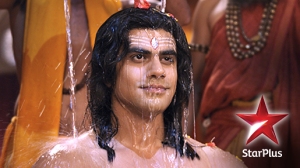 In the Hindu Scriptures, Ashwathama is counted among the seven immortals, who have forever escaped death. The verse goes like: Ashwathama Balir-Vyaso, Hanumanscha Vibhishanah. Kripah Parashuramascha, Saptaite Chirajivinah. Meaning, Ashwathama, Demon Bali, Rishi Vyas, Hanuman, Demon Vibhishan, Kripa Acharya and Parashuram are the seven immortals. In Sanskrit writing:
In the Hindu Scriptures, Ashwathama is counted among the seven immortals, who have forever escaped death. The verse goes like: Ashwathama Balir-Vyaso, Hanumanscha Vibhishanah. Kripah Parashuramascha, Saptaite Chirajivinah. Meaning, Ashwathama, Demon Bali, Rishi Vyas, Hanuman, Demon Vibhishan, Kripa Acharya and Parashuram are the seven immortals. In Sanskrit writing: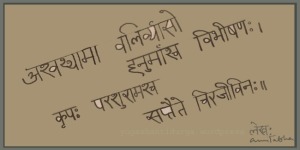 Sage Angirasa was a direct son of Brahma-deva, the creator. Sage Brihaspati (the Guru of Indra), is the son of Angirasa. Sage Bharadwaj was the son of Brihaspati. Acharya Drona was the son of Bharadwaj and the father of Ashwathama. Thus one may say that Aswathama is the direct lineage holder of the Bharadwaj Gotra and numerous persons born in this Gotra(blood line from some sage) are his descendants. Also note that Kripa-acharya, another immortal, is Ashwathama’s uncle… his mother’s brother. By birth Aswathama is from the Brahmin caste, not a Ksatriya (warrior). But by his Karma in his first 40-50 years, he indeed was a supreme warrior.
Sage Angirasa was a direct son of Brahma-deva, the creator. Sage Brihaspati (the Guru of Indra), is the son of Angirasa. Sage Bharadwaj was the son of Brihaspati. Acharya Drona was the son of Bharadwaj and the father of Ashwathama. Thus one may say that Aswathama is the direct lineage holder of the Bharadwaj Gotra and numerous persons born in this Gotra(blood line from some sage) are his descendants. Also note that Kripa-acharya, another immortal, is Ashwathama’s uncle… his mother’s brother. By birth Aswathama is from the Brahmin caste, not a Ksatriya (warrior). But by his Karma in his first 40-50 years, he indeed was a supreme warrior.